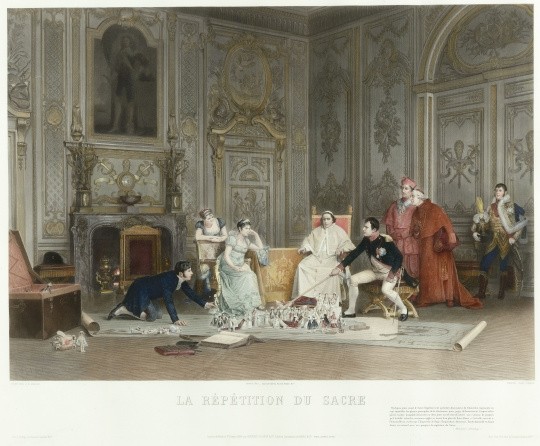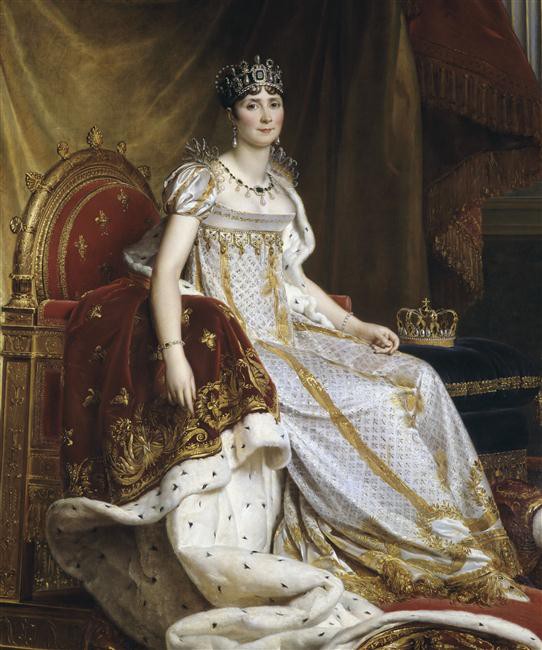The coronation and consecration ceremony or “Sacre”
This massive painting of the Empress Josephine enthroned in majesty recalls 2 December 1804, the day of the “Sacre” [coronation and consecration], an historic moment when the imperial couple was at its zenith. The historian Pierre Branda* describes it as follows: “The great day of the coronation had finally arrived. The doors of Notre-Dame Cathedral opened before the majesty of the imperial couple. Josephine was radiant as she walked in Napoleon’s footsteps. The whole of France was watching. Even the Pope came to attend their coronation. (…) Behind the scenes, Napoleon, like a stage director, had prepared and carefully rehearsed everything.”

Representation of power
The Empress sits on the throne that Jacob-Desmalter made in 1805 and which is now kept in the Château de Fontainebleau. Next to her, on a cushion lies the gold crown decorated with coloured stones and pearls (today lost). The Empress’s “grand habillement” was designed by Isabey and Percier and includes “a large purple velvet cape (22.60 m long) decorated with gold bees made by the dressmakers Leroy and Rimbaud; embroidered branches of laurel, oak and olive tree are intertwined, surrounding the letter “N”. The lining and border are made of ermine. The cape is fastened on the left shoulder and held by a clasp fixed to the belt on the left side. The dress also is embroidered with gold bees. The bodice and the top of the sleeves are adorned with brilliant diamonds (…) the diadem, the necklace and the earrings are made of engraved stones, surrounded by diamonds: the collar is made of gold lace” (Marc Allegret, “Analyse de quatre oeuvres de François Gérard”, Revue du Souvenir Napoléonien, 1996 n° 406, p. 63).
Imperial splendour
The Empress’s appearance always played a key role in the display of sovereignty. The diadem as a symbol of power is the key detail. As ever in her official appearances, this headpiece, set with spectacular stones and pearls, was part of a perfectly matched ensemble comprising (in addition) a comb, a pair of bracelets, a necklace and earrings. The latter two are adorned with baroque pear-shaped pearls, of which the Empress was particularly fond and which she can be seen wearing in several other portraits.
This official portrait of Josephine welcomed visitors to the exhibition “Joséphine et Napoléon, une histoire (extra)ordinaire”, curated by Pierre Branda held from mid-May to 18 July 2021 in the grand salons of the Chaumet town house at 12 Vendôme in Paris. The painting, featuring the first major client and inspiration to the jeweller Nitot (founder of the house that is today called Chaumet), was loaned by the Château de Fontainebleau.
Restoration of the work
After the exhibition, this painting will be restored. The layers of varnish will be progressively thinned and the old restorations and wear and tear will be harmonised by applying glazes. This intervention will improve the state of conservation as well as the appearance of this work. It has been made possible through the sponsorship of Chaumet, in accordance with the company’s long-standing commitment to the preservation and transmission of its heritage.
text by Maison Chaumet, June 2021 (translation RY and PH)


